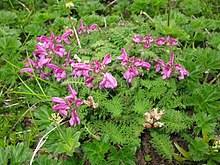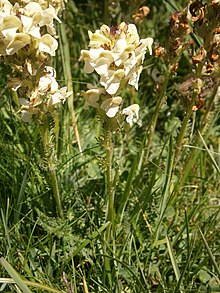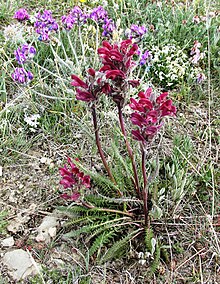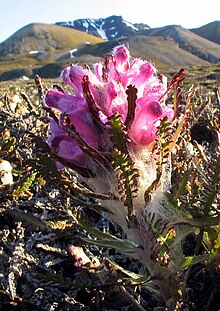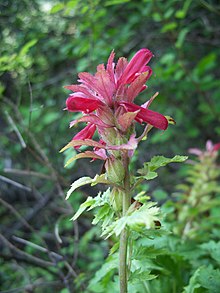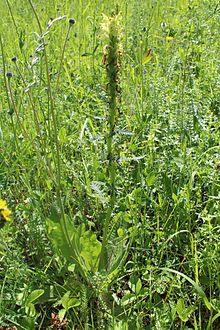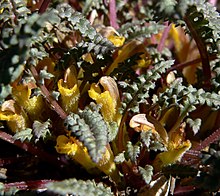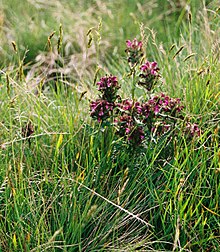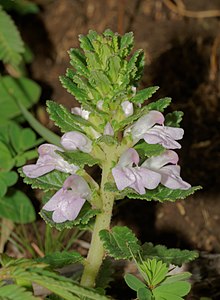Lice herbs
| Lice herbs | ||||||||||||
|---|---|---|---|---|---|---|---|---|---|---|---|---|

Whorled louse herb ( Pedicularis verticillata ) |
||||||||||||
| Systematics | ||||||||||||
|
||||||||||||
| Scientific name | ||||||||||||
| Pedicularis | ||||||||||||
| L. |
The plant genus of the louse herbs ( Pedicularis ) belongs to the family of summer root plants (Orobanchaceae). It includes around 600 species in the northern hemisphere .
description





Vegetative characteristics
Lousewort species grow as perennial or annual, rarely biennial herbaceous plants .
The leaves are alternate, opposite or distributed in whorls on the stem. The lower leaves are usually long-stalked and the upper ones are often more or less sessile. The leaf blades are usually pinnate or pinnate, rarely simply with a smooth or serrated edge.
Generative characteristics
There is a terminal inflorescence or the flowers are in the leaf axils. The bracts are mostly foliage-like.
The hermaphrodite flowers are zygomorphic and have a double flower envelope . The sepals are fused tubular to bell-shaped; the calyx is often more or less two-lipped and mostly deeply split into rarely two to mostly five calyx teeth. The purple, red, yellow or white petals are fused; the crown is strongly two-lipped. In most species, the corollas are slightly screwy and twisted a little to the side off the center line, seen from the front to the left. The upper lip envelops the anthers like a hood, is compressed, rounded or trimmed at the sides and ends in teeth or a beak. The three corolla lobes of the lower lip are mostly spread out and in the bud stage outside the upper lip. There are four stamens . The stamens are hairless or hairy and the anthers can have a spike tip. The scars are heady.
The columnar (= loculicidal) capsule fruits can appear somewhat compressed and contain many seeds. The seeds have a net-like or ribbed surface.
ecology
All lice herb species are semi-parasites that use suction organs ( haustoria ) to remove water and nutrient salts from the roots of host plants . The plants can therefore also thrive in dry locations, although they themselves have not developed any protection against evaporation. Once picked, lice herbs wither quickly.
Alpine lice herb species are completely adapted to bumblebees as pollinators .
Toxicity
Weed plants taste fiery hot and have an unpleasant smell, so grazing cattle avoid them. Consumption is believed to cause intestinal inflammation and blood urination .
Aucubin makes all parts of the plant, especially the seeds, poisonous.
Systematics and distribution
The genus Pedicularis was set up in 1753 by Carl von Linné in Species Plantarum , 2, pages 607-610. Pedicularis sylvatica L. was introduced as a lectotype species in 1930 by Francis Whittier Pennell in Proceedings of the Academy of Natural Sciences of Philadelphia. , Volume 82, page 18. A synonym for Pedicularis L. is Pediculariopsis Á.Löve & D.Löve .
The genus Pedicularis belongs to the Orobanchaceae family ; earlier it was assigned to the Scrophulariaceae family .
The genus Pedicularis is widespread in the cold and alpine areas of the northern hemisphere . There are 352 species in China, 271 of them only there. The center of biodiversity with most species is in the mountains of southwest China.
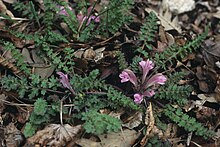

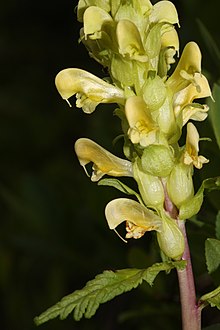

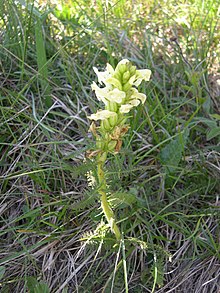




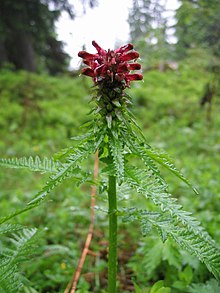






There are around 600 types of pedicularis (selection):
- Pedicularis abrotanifolia M.Bieberstein ex Steven : It occurs in Xinjiang , Kazakhstan , Mongolia and western Siberia .
- Stemless lice herb ( Pedicularis acaulis Scop. ): It occurs in Italy , Croatia and Slovenia .
- Pedicularis achilleifolia Stephan ex Willd. : It occurs in northeastern Xinjiang, Kazakhstan, Kyrgyzstan , Mongolia and Siberia.
- Pedicularis acmodonta Boiss. : It only occurs in Armenia .
-
Pedicularis alaschanica Maxim. : There are two subspecies:
- Pedicularis alaschanica Maxim. subsp. alaschanica : It thrives at altitudes of 3900 to 5100 meters in northeastern and southeastern Tibet , in Inner Mongolia and in the Chinese provinces of Gansu , Ningxia and Qinghai .
- Pedicularis alaschanica subsp. tibetica (Maxim.) PCTsoong : It thrives on rocky grass slopes at altitudes of 4000 to 4700 meters only in southern to southwestern Tibet.
- Pedicularis aloensis Hand.-Mazz. : This endemic thrives in bamboo thickets and in forests at altitudes of 3000 to 4000 meters only in northwestern Yunnan .
-
Pedicularis alopecuros Franch. ex Maxim. : There are two varieties:
- Pedicularis alopecuros Franch. ex Maxim. var. alopecuros : It thrives on alpine mats at altitudes of 2300 to 4000 meters in southwest Sichuan and northern Yunnan.
- Pedicularis alopecuros var. Lasiandra P.C. Tsoong : It occurs in Sichuan.
- Pedicularis altaica Stephan ex Steven : It occurs in Xinjiang, Kazakhstan, Mongolia and the Altai .
- Pedicularis altifrontalis P.C. Tsoong : This endemic thrives in swampy meadows at altitudes of 3800 to 4600 meters in southeastern Tibet.
- Pedicularis amoena Steven : It occurs only in the northern European part of Russia .
- Pedicularis amplituba H.L.Li : This endemic thrives on rocky slopes at altitudes of around 3500 meters only in northwestern Yunnan.
-
Pedicularis anas Maxim. : There are three varieties:
- Pedicularis anas Maxim. var. anas : It thrives on alpine mats at altitudes of 3000 to 4300 meters in the Chinese provinces of southern Gansu and northern and western Sichuan.
- Pedicularis anas var. Tibetica Bonati : It grows 3600 to 4400 meters in eastern Tibet and western Sichuan.
- Pedicularis anas var. Xanthantha (HLLi) PCTsoong : This endemic thrives on alpine mats at altitudes of 3300 to 3700 meters in southwestern Gansu.
- Pedicularis angularis P.C. Tsoong : This endemic thrives on slopes at altitudes of around 3800 meters only in northwestern Sichuan.
- Pedicularis angustilabris H.L.Li : It thrives on alpine mats at altitudes of 3000 to 4000 meters in western Sichuan and northwestern Yunnan.
- Pedicularis angustiloba P.C. Tsoong : It thrives on loose moraines and in dry locations in forests at altitudes of 3400 to 4500 meters only in eastern Tibet.
- Pedicularis anomala P.C. Tsoong & HPYang : It thrives in Abies forests at altitudes of 3200 by 3800 meters only in eastern Tibet.
-
Pedicularis anthemifolia fish. ex Colla : There are two subspecies:
- Pedicularis anthemifolia fish. ex Colla subsp. anthemifolia : It occurs from the European part of Russia via Siberia to Mongolia and northern Xinjiang.
- Pedicularis anthemifolia subsp. elatior (rule) PCTsoong : It occurs in Kazakhstan, Kyrgyzstan and western Xinjiang.
- Pedicularis aquilina Bonati : It occurs in Yunnan.
-
Pedicularis armata Maxim. : There are two varieties:
- Pedicularis armata Maxim. var. armata : It thrives on alpine mats at altitudes of 3700 to 4600 meters in the Chinese provinces of southwestern Gansu and northern Sichuan.
- Pedicularis armata var. Trimaculata X.F.Lu : It thrives on alpine meadows in humid or sunny locations and peat at altitudes of 3000 to 4000 meters in the Chinese provinces of Gansu and Qinghai.
- Pedicularis armena Boiss. & A.Huet : It only occurs in Armenia.
-
Pedicularis artselaeri Maxim. : There are two varieties:
- Pedicularis artselaeri Maxim. var. artselaeri : It thrives in damp locations, stony slopes and in forests at altitudes of 1000 to 2800 meters in the Chinese provinces of Hebei, Hubei, Shaanxi , Shanxi and northeastern Sichuan.
- Pedicularis artselaeri var. Wutaiensis Hurusawa : It occurs in the Chinese province of Shanxi.
- Ascending lice herb ( Pedicularis ascendens Gaudin ): It occurs from France via Switzerland to Italy .
- Pedicularis asparagoides Lapeyr. : It occurs from Spain to France.
- Fern-leaved louse herb , Salzburg louse herb ( Pedicularis asplenifolia Willd. ): It occurs from Austria to Switzerland to Italy .
- Pedicularis aschistorrhyncha Marquand & Shaw : This endemic thrives on swampy meadows at altitudes of 3400 to 3600 meters only in southeastern Tibet .
- Pedicularis atropurpurea north m. : It occurs in the Asian part of Turkey .
- Pedicularis atroviridis P.C. Tsoong : This endemic thrives on moss-covered slopes at altitudes of around 4100 meters only in southeastern Tibet .
- Pedicularis attollens A.Gray : It occurs in the western US states of Oregon and California .
- Pedicularis atuntsiensis Bonati : This endemic thrives at altitudes of 4300 to 4500 meters only in northwestern Yunnan.
- Pedicularis aurata (Bonati) HLLi : It thrives in bamboo thickets and pine forests at altitudes of 3300 to 3900 meters in southeastern Tibet and northwestern Yunnan.
-
Pedicularis axillaris Franch. ex Maxim. : There are two subspecies:
- Pedicularis axillaris Franch. ex Maxim. subsp. axillary : It thrives at altitudes of 3,000 to 4,000 meters in southeastern Tibet, southwestern Sichuan and northwestern Yunnan.
- Pedicularis axillaris subsp. balfouriana (Bonati) PCTsoong : This endemic thrives on open pastures at altitudes of 2700 to 3400 meters only in northwestern Yunnan.
- Pedicularis batangensis Bureau & Franch. : It thrives on open rocky slopes at altitudes of 2500 to 3100 meters only in northwest to western Sichuan.
- Pedicularis baumgartenii Simonk. : It occurs in Romania.
- Pedicularis bella Hook. f. : There are two subspecies:
- Pedicularis bicolor Diels : It occurs only in southeast Shaanxi.
- Pedicularis bidentata Maxim. : It occurs in northern Sichuan.
- Pedicularis habenii Franch. : It thrives in alpine regions in southeastern Tibet and western Sichuan.
- Pedicularis binaria Maxim. : It thrives on alpine mats at altitudes of around 4000 meters only in northern Sichuan.
- Pedicularis bomiensis H.P. Yang : It thrives in the thicket at altitudes of around 3200 meters in eastern Tibet.
- Pedicularis brachycrania H.L.Li : It thrives near glacial lakes in southwestern Sichuan and northeastern Yunnan.
- Pedicularis brachyodonta lock. & Vuk. : It occurs from Serbia, Kosovo and Vojvodina, Croatia via Albania to Greece.
- Pedicularis bracteosa Benth. : The varieties are common in western North America from Canada to the USA.
- Pedicularis breviflora Regel & C.Winkler : It occurs in Xinjiang as well as Kazakhstan and perhaps in Kyrgyzstan.
- Pedicularis brevilabris Franch. : It thrives on alpine mats and in the thicket at altitudes of 2700 to 3500 meters in southwestern Gansu and northwestern to western Sichuan.
- Pedicularis canadensis L .: It is widespread in North America from Canada to the USA.
- Mont Cenis louse herb ( Pedicularis cenisia Gaudin ): It occurs from France to Italy.
- Pedicularis centranthera A. Gray : It is widespread in the United States.
-
Pedicularis cephalantha Franch. ex Maxim. : There are two varieties:
- Pedicularis cephalantha Franch. ex Maxim. var. cephalantha : It thrives on alpine meadows and Picea forests at altitudes of 4,000 to 4,900 meters in northwestern Yunnan.
- Pedicularis cephalantha var. Szetchuanica Bonati : It thrives on alpine mats at altitudes of 2800 to 4500 meters in southern Sichuan and in Yunnan.
-
Pedicularis cernua Bonati : There are two subspecies:
- Pedicularis cernua Bonati subsp. cernua : It thrives on alpine mats at altitudes of 3800 to 4000 meters in southwestern Sichuan and in northwestern Yunnan.
- Pedicularis cernua subsp. latifolia (HLLi) PCTsoong : This endemic thrives on alpine mats at altitudes of around 4200 meters only in the upper Kiukiang Valley in Yunnan.
- Pedicularis chamissonis Steven : It occurs from the Japanese islands of Hokkaido and Honshu via the Kuriles , Sakhalin to Kamchatka and in Alaska .
-
Pedicularis cheilanthifolia Schrenk : There are two subspecies:
- Pedicularis cheilanthifolia Schrenk subsp. cheilanthifolia : It occurs in Afghanistan , Kazakhstan , Kyrgyzstan , Tajikistan , India , Mongolia , northern Tibet and in the Chinese provinces of Gansu, Qinghai and Xinjiang.
- Pedicularis cheilanthifolia subsp. svenhedinii (Paulsen) PCTsoong : It occurs in India and western Tibet.
- Pedicularis chengxianensis Z.G.Ma & ZZMa : This endemic thrives on steep slopes and in shrubs at altitudes of 1600 to 1700 meters only in Chengxian and Jishan in Gansu.
- Pedicularis chenocephala Diels : It thrives on swampy alpine mats at altitudes of 3600 to 4300 meters in southwestern Gansu and northern Sichuan.
- Pedicularis chinensis Maxim. : It thrives on alpine mats at altitudes of 1700 to 2900 meters in Inner Mongolia and in the Chinese provinces of central to southern Gansu, Hebei, northeastern Qinghai , Shaanxi and Shanxi .
- Pedicularis chingii Bonati : It thrives in wooded areas at altitudes of 3000 to 4200 meters only in southern Gansu.
- Pedicularis chumbica Prain : It occurs in Sikkim and southern Tibet.
- Pedicularis cinerascens Franch. : It thrives on grassy slopes at altitudes of 4000 to 4400 meters only in western Sichuan.
- Pedicularis clarkei Hook. f. : It occurs in southern Tibet, Bhutan, Nepal, Sikkim and India.
- Scaly lice herb ( Pedicularis comosa L. ): It occurs from southern, south-eastern and eastern Europe to the Caucasus and Turkey.
- Pedicularis comptoniifolia Franch. ex Maxim. : It occurs in Myanmar and in the Chinese provinces of southwest Sichuan and Yunnan.
-
Pedicularis confertiflora Prain : There are two subspecies:
- Pedicularis confertiflora Prain subsp. confertiflora : It occurs in Bhutan, Nepal, Sikkim, in southern Tibet and in the Chinese provinces of southwest Sichuan and Yunnan.
- Pedicularis confertiflora subsp. parvifolia (Handel-Mazzetti) PCTsoong : It only thrives at altitudes of 3800 to 4900 meters in northwestern Yunnan.
- Pedicularis confluens P.C. Tsoong : It thrives in bamboo groves at altitudes of around 1300 meters only in western-central Guizhou.
- Pedicularis conifera Maxim. ex Forbes & Hemsl. : It only occurs in western Hubei.
- Pedicularis connata H.L.Li : It thrives in forests in valleys at altitudes of 4,000 to 4,300 meters in the Chinese provinces of southwestern Sichuan and northwestern Yunnan.
- Pedicularis corydaloides Hand .-- Mazz. : It thrives in forests, on slopes, in alpine meadows at altitudes of 3200 to 3800 meters in southeastern Tibet and northwestern Yunnan.
- Pedicularis corymbifera H.P. Yang : It thrives on open rocky slopes and in open forests at altitudes of around 3400 meters only in eastern Tibet.
-
Pedicularis cranolopha Maxim. : There are three varieties:
- Pedicularis cranolopha Maxim. var. cranolopha : It thrives on alpine mats at altitudes of around 3800 meters in the Chinese provinces of southwestern Gansu, northeastern Qinghai and northern Sichuan.
- Pedicularis cranolopha var. Garnieri (Bonati) PCTsoong : It occurs only in western Sichuan.
- Pedicularis cranolopha var. Longicornuta Prain : It thrives on alpine mats at altitudes of 2600 to 4200 meters in the Chinese provinces of southwestern Gansu, northeastern Qinghai, Sichuan and northwestern Yunnan.
- Pedicularis craspedotricha Maxim. : It thrives on alpine meadows and in forests at altitudes of 3400 to 4500 meters in the Chinese provinces of Gansu and northwestern Sichuan.
-
Pedicularis crenata Maxim. : There are two subspecies:
- Pedicularis crenata Maxim. subsp. crenata : It thrives on alpine mats and on grassy slopes at altitudes of 2600 to 3000 meters only in northwestern Yunnan.
- Pedicularis crenata subsp. crenatiformis (Bonati) PCTsoong : It thrives between limestone cliffs at altitudes of 3300 to 3400 meters only in northwestern Yunnan.
- Pedicularis crenularis H.L.Li : It occurs only in western Sichuan.
- Pedicularis crenulata Benth. : It occurs in western North America.
- Pedicularis cristatella Pennell & HLLi : It thrives on rock faces, on meadows in valleys and on open or shrubby grasslands at altitudes of 1900 to 3000 meters in the Chinese provinces of southwestern Gansu and northern Sichuan.
- Pedicularis croizatiana Benth. : It thrives on alpine meadows and in pine forests at altitudes of 3700 to 4200 meters in southeastern Tibet and southwestern Sichuan.
-
Pedicularis cryptantha C. Marquand & Airy Shaw : There are two subspecies:
- Pedicularis cryptantha C. Marquand & Airy Shaw subsp. cryptantha : It thrives on grassy banks of rivers and in forests at altitudes of 2700 to 4700 meters only in southeastern Tibet.
- Pedicularis cryptantha subsp. erecta P.C. Tsoong : It thrives in pine forests just south-eastern Tibet.
-
Pedicularis curvituba Maxim. : There are two subspecies:
- Pedicularis curvituba Maxim. subsp. curvituba : It occurs only in northern and southwestern Gansu.
- Pedicularis curvituba subsp. provotii (Franch.) PCTsoong : It thrives on open slopes at altitudes of about 1,600 meters in Inner Mongolia and in the Chinese provinces of southeastern Gansu, northern Hebei and northern Shaanxi.
- Pedicularis cyathophylla Franch. : It thrives on alpine mats at altitudes of around 4700 meters only in the Chinese provinces of southwestern Sichuan and northwestern Yunnan.
- Pedicularis cyathophylloides H. Limpr. : It thrives in Picea forests and Betula forest lands at altitudes of 3500 to 3900 meters in northeastern Tibet and northwestern Sichuan.
- Pedicularis cyclorhyncha H.L.Li : It thrives in wet meadows only in northwestern Yunnan.
- Pedicularis cymbalaria Bonati : It thrives on alpine mats, on stony soils and in shady locations at altitudes of 3400 to 4000 meters only in the Chinese provinces of southwestern Sichuan and northwestern Yunnan.
- Pedicularis cystopteridifolia Rydb. : It occurs only in the US states of Montana and Wyoming .
- Pedicularis daltonii Prain : It occurs in Bhutan, Sikkim and in southern to southeastern Tibet.
- Pedicularis daochengensis H.P. Yang : It thrives in Abies fabri forestsand on slopes at altitudes of 3900 to 4200 meters in Sichuan.
- Pedicularis dasyantha Hadač : It is a floral element of the arctic tundra and occurs only on Svalbard , on Novaya Zemlya and in western Taimyr peninsula .
- Pedicularis dasystachys Schrenk : It is distributed from the European part of Russia through western Siberia and Kazakhstan to Xinjiang and Mongolia.
- Pedicularis dahcifolia Bonati : It occurs only in western Sichuan.
-
Pedicularis davidii Franch. : There are three varieties:
- Pedicularis davidii Franch. var. davidii : It thrives on grassy slopes and plains, in thickets, in forests and along rivers at altitudes of 1700 to 3500 meters in the Chinese provinces of southwest Gansu, southwest Shaanxi and Sichuan.
- Pedicularis davidii var. Pentodon P.C.Tsoong : It thrives on alpine meadows at elevations from 3,200 to 4,400 meters only in northwestern Sichuan.
- Pedicularis davidii var. Platyodon P.C.Tsoong : It grows on roadsides at elevations from 1,400 to 2,300 meters only in the eastern Sichuan.
-
Pedicularis debilis Franch. ex Maxim. : There are two subspecies:
- Pedicularis debilis subsp. debilior P.C.Tsoong : It occurs only in the northwest Yunnan.
- Pedicularis debilis Franch. ex Maxim. subsp. debilis : It thrives on the edges of forests at altitudes of around 4000 meters only in northwestern Yunnan.
- Pedicularis decora Franch. : It thrives on grassy slopes, in Picea and Betula forest lands at altitudes of 2200 to 2800 meters in the Chinese provinces of southern Gansu, western Hubei, southern Shaanxi and northeastern Sichuan.
- Pedicularis decorissima Diels : It thrives on alpine mats at altitudes of 2900 to 3500 meters in the Chinese provinces of southwestern Gansu, eastern Qinghai and western Sichuan.
- Pedicularis deltoidea Franch. ex Maxim. : It thrives on grassy slopes at altitudes of 2,600 to 3,500 meters in the Chinese provinces of southwestern Sichuan and northwestern Yunnan.
- Pedicularis densiflora Benth. : It occurs in the western US state of California and southern Oregon.
-
Pedicularis densispica Franch. ex Maxim. : There are three subspecies:
- Pedicularis densispica Franch. ex Maxim. subsp. densispica : It thrives in swamp meadows and forests at altitudes from 1900 to 4400 meters in southeastern Tibet and in the Chinese provinces of western Sichuan and northwestern Yunnan.
- Pedicularis densispica subsp. schneideri (Bonati) PCTsoong : It thrives on alpine mats at altitudes of 2700 to 4300 meters in southern to southeastern Tibet and in the Chinese provinces of western Sichuan and northwestern Yunnan.
- Pedicularis densispica subsp. viridescens P.C. Tsoong : It occurs only in southeastern Tibet.
- Pedicularis deqinensis H.P. Yang : It thrives in forests with Quercus semecarpifolia and in river valleys at altitudes of 2900 to 3400 meters only in northwestern Yunnan.
- Pedicularis dichotoma Bonati : It thrives in open alpine pastures and open forests at altitudes of 2700 to 4300 meters in eastern Tibet and in the Chinese provinces of southwestern Sichuan and northwestern Yunnan.
- Pedicularis dichrocephala Hand .-- Mazz. : It thrives on alpine mats at altitudes of 3300 to 3500 meters only in northwestern Yunnan.
- Pedicularis dielsiana Bonati : It thrives in meadows and on grassy slopes at altitudes of 2000 to 2500 meters in the Chinese provinces of western Hubei and central Sichuan.
-
Pedicularis diffusa Prain : There are two subspecies:
- Pedicularis diffusa Prain subsp. diffusa : It occurs in the Himalayas in Bhutan , central and eastern Nepal , Sikkim and southern Tibet.
- Pedicularis diffusa subsp. elatior P.C. Tsoong : This endemic thrives on the banks of flowing waters and stony locations at altitudes of around 3800 meters only in southeastern Tibet.
- Pedicularis dissecta (Bonati) Pennell & HLLi : This endemic thrives on rocks at altitudes of around 3000 meters only in southwestern Shaanxi.
- Pedicularis dissectifolia H.L.Li : It occurs only in northwestern Yunnan.
- Pedicularis dolichantha Bonati : It thrives in meadows on still waters at altitudes of around 3200 meters only in eastern Yunnan.
- Pedicularis dolichocymba Hand .-- Mazz. : It thrives on alpine meadows, on rocky slopes and between boulders at altitudes of 3500 to 4300 meters in eastern Tibet and in the Chinese provinces of western Sichuan and northwestern Yunnan.
- Pedicularis dolichoglossa H.L.Li : It occurs only in northwestern Yunnan.
- Pedicularis dolichorrhiza Schrenk : It occurs in Kazakhstan , Kyrgyzstan , Tajikistan , Afghanistan and northwestern Xinjiang.
- Pedicularis dolichostachya H.L.Li : It thrives on grasslands at altitudes of around 3700 meters only in western Sichuan.
- Pedicularis duclouxii Bonati : It thrives on alpine meadows, on grassy slopes and in forests at altitudes of 3400 to 4300 meters in the Chinese provinces of southwestern Sichuan and northwestern Yunnan.
- Pedicularis dulongensis H.P. Yang : It thrives on wet meadows on mountain slopes at altitudes of 3500 to 3600 meters only in northwestern Yunnan.
- Pedicularis dunniana Bonati : It thrives on grassy slopes and in forests at altitudes of 3300 to 3800 meters in the Chinese provinces of western Sichuan and northwestern Yunnan.
- Pedicularis elata Willd. : It occurs in Kazakhstan, Siberia, Mongolia and Xinjiang.
- Pedicularis elliotii P.C. Tsoong : It thrives on the banks of rivers and in damp locations at altitudes of around 4,000 meters only in eastern Tibet.
-
Long -eared louse weed, extended lice weed, long-eared lice weed, long-eared lice weed ( Pedicularis elongata A.Kern. ): There are about two subspecies:
- Pedicularis elongata A. core. subsp. elongata : This endemic occurs only in Slovenia .
- Pedicularis elongata subsp. julica ( E. Mayer ) Hartl : It thrives in the southern Alps in Italy , Austria, Liechtenstein and Slovenia.
-
Pedicularis elwesii Hook. f. : There are three subspecies:
- Pedicularis elwesii Hook. f. subsp. elwesii : It occurs in the Himalayas in Bhutan, Nepal, Sikkim, northern Myanmar , southern to southeastern Tibet and northwestern Yunnan.
- Pedicularis elwesii subsp. major (HLLi) PCTsoong : It occurs in southeastern Tibet and northwestern Yunnan.
- Pedicularis elwesii subsp. minor (HLLi) PCTsoong : It thrives on alpine mats at altitudes of around 3800 meters only in eastern Tibet.
- Pedicularis excelsa Hook. f. : It occurs in the Himalayas in Bhutan, central Nepal, Sikkim and in southeastern Tibet.
- Pedicularis fargesii Franch. : It thrives in pine and fir forests and on grassy slopes at altitudes of 1400 to 1800 meters in the Chinese provinces of southern Gansu, western Hubei, Hunan and eastern Sichuan.
- Pedicularis fastigiata Franch. : It occurs only in northwestern Yunnan.
- Pedicularis fengii H.L.Li : It thrives on hills in open locations and on alpine meadows in the Chinese provinces of Sichuan and northwestern Yunnan.
- Pedicularis fetisowii rule : It thrives in valleys at altitudes of about 2000 meters only in eastern Xinjiang.
- Pedicularis filicifolia Hemsl. : It thrives in forests at altitudes of 1400 to 1500 meters only in western Hubei.
-
Pedicularis filicula Franch. : There are two varieties:
- Pedicularis filicula Franch. var. filicula : It thrives on alpine mats at altitudes of 2800 to 4900 meters only in northwestern Yunnan.
- Pedicularis filicula var. Saganaica Hand .-- Mazz. : It occurs in southwest Sichuan as well as in Yunnan.
- Pedicularis filiculiformis P.C.Tsoong : It occurs in Bhutan and southeastern Tibet.
- Pedicularis flaccida Prain : It occurs only in western Sichuan.
- Pedicularis flava Pallas : It occurs in eastern Siberia, Mongolia and the northern part of Inner Mongolia.
- Pedicularis fletcheri P.C. Tsoong : It occurs in Bhutan and in southeastern Tibet.
- Pedicularis flexuosa Hook. f. : It occurs in the Himalayas in Bhutan, central and eastern Nepal, Sikkim and southern Tibet.
- Pedicularis floribunda Franch. : It thrives on rocky slopes at altitudes of 2300 to 2700 meters only in western Sichuan.
- Leafy louse herb , leaf lice herb , leaf louse herb ( Pedicularis foliosa L. ): It thrives in the mountains of Europe from the Pyrenees and the Alps (especially the Northern Alps) to the Balkans . There are localities for the countries of northern Spain , France , Germany , Italy, Switzerland , Austria and Croatia .
-
Pedicularis forrestiana Bonati : There are two subspecies:
- Pedicularis forrestiana subsp. flabellifera P.C. Tsoong : It occurs only in northwestern Yunnan.
- Pedicularis forrestiana Bonati subsp. forrestiana : It thrives on alpine meadows and on open sites at altitudes of 3300 to 4000 meters only in northwestern Yunnan.
- Pedicularis fragarioides P.C. Tsoong : It thrives on stony slopes at altitudes of around 4700 meters only in northwest Sichuan.
- Pedicularis franchetiana Maxim. : It only occurs in western Sichuan.
- Friedrich August louse herb ( Pedicularis friderici-augusti Tomm. ): It occurs in Italy, Croatia , Slovenia, Serbia (including Kosovo and Vojvodina ), Albania and Greece .
- Pedicularis furbishiae S. Watson : This endemic occurs only in the upper reaches of the Saint John River in Maine and New Brunswick .
- Pedicularis furfuracea : It occurs in the Himalayas in Bhutan, in the Darjeeling district , in central and eastern Nepal, in Sikkim and in southern Tibet.
- Pedicularis gagnepainiana Bonati : It occurs only in western Guizhou .
- Pedicularis galeata Bonati : It thrives on grassy slopes at altitudes of 3500 to 4400 meters only in northwestern Yunnan.
- Pedicularis ganpinensis Vaniot ex Bonati : It thrives on grassy slopes at altitudes of around 1300 meters only in western-central Guizhou.
- Pedicularis garckeana Prain ex Maxim. : It occurs only in Sikkim and southern Tibet.
- Pedicularis geosiphon H.Smith & PCTsoong : It thrives on moss-covered locations in old stands of pine forests at altitudes of 3500 to 3900 meters in the Chinese provinces of southern Gansu and northern Sichuan.
- Pedicularis giraldiana Bonati : It thrives at altitudes of 2900 to 3000 meters only in southern Shaanxi.
- Pedicularis glabrescens H.L.Li : It thrives on moist slopes at altitudes of around 3500 meters only in northwestern Yunnan.
- Pedicularis globifera Hook. f. : It occurs in the Himalayas in Nepal as well as Sikkim and in southern to southeastern Tibet.
- Pedicularis gongshanensis H.P.Yang : This endemic thrives at altitudes of about 3600 meters only in Gongshan in northwestern Yunnan.
- Pedicularis gracilicaulis H.L.Li : It thrives on alpine mats at altitudes of 3000 to 3300 meters only in northwestern Yunnan.
-
Pedicularis gracilis Wall. ex Benth. : There are three subspecies:
- Pedicularis gracilis Wall. ex Benth. subsp. gracilis : It occurs in Afghanistan , Pakistan and in the Himalayas in Bhutan, Nepal as well as Sikkim and in southern Tibet.
- Pedicularis gracilis subsp. macrocarpa (Prain) PCTsoong : It occurs in India and southern Tibet.
- Pedicularis gracilis subsp. sinensis (HLLi) PCTsoong : It thrives on alpine mats and on grassy slopes at altitudes of 2000 to 4000 meters in western Sichuan and northwestern Yunnan.
-
Pedicularis gracilituba H.L.Li : There are two subspecies:
- Pedicularis gracilituba H.L.Li subsp. gracilituba : It thrives on alpine meadows and in forests at altitudes of 3600 to 4000 meters only in southwest Sichuan.
- Pedicularis gracilituba subsp. setosa (HLLi) PCTsoong : This endemic thrives in forests at altitudes of around 3300 meters only in northwestern Yunnan.
- Pedicularis grandiflora fish. : It occurs in Russia, Inner Mongolia and Jilin.
- Pedicularis groenlandica Retz.
-
Pedicularis gruina Franch. ex Maxim. : There are three subspecies:
- Pedicularis gruina Franch. ex Maxim. subsp. gruina : It thrives on alpine mats in forests and in damp locations at altitudes of 2600 to 3000 meters only in northwestern Yunnan.
- Pedicularis gruina subsp. pilosa (Bonati) PCTsoong : It only thrives in mountainous locations at altitudes of around 2600 meters in northwestern Yunnan.
- Pedicularis gruina subsp. polyphylla (Franch. ex Maxim.) PCTsoong : It thrives on alpine mats at altitudes of 2800 to 3000 meters only in northwestern Yunnan.
- Pedicularis gyirongensis H.P. Yang : This endemic thrives in mixed forests on hills at altitudes of around 2400 meters only in Gyirong in southern Tibet.
- Twisted-flowered lice herb ( Pedicularis gyroflexa Vill. ): It occurs only from France via Switzerland to Italy.
-
Pedicularis gyrorhyncha Franch. ex Maxim. : There have been two varieties since 2008:
- Pedicularis gyrorhyncha var. Glabrisepala H.Wang & WBYu : It was first described in 2008. It thrives at altitudes of 3400 to 4000 meters only in southwest Sichuan.
- Pedicularis gyrorhyncha Franch. ex Maxim. var. gyrorhyncha : It thrives on moist subsoil and in forest clearings at altitudes of 2700 to 4000 meters only in northwestern Yunnan.
-
Pedicularis habachanensis Bonati : There are two subspecies:
- Pedicularis habachanensis Bonati subsp. habachanensis : It thrives on swampy alpine mats at altitudes of 4100 to 4600 meters only in northwestern Yunnan.
- Pedicularis habachanensis subsp. multipinnata P.C. Tsoong : It occurs only in northwestern Yunnan.
- Karst lice herb , Hacquet lice herb ( Pedicularis hacquetii Graf ): It occurs in Poland , Austria , Liechtenstein , Italy, Slovakia , Slovenia , Croatia , Romania and the Ukraine .
- Pedicularis hemsleyana Prain : It thrives at altitudes of 2900 to 4000 meters only in western Sichuan.
- Pedicularis henryi Maxim. : It occurs in Laos, Vietnam and the Chinese provinces of northern Guangdong, northwestern Guangxi, western Guizhou, Hubei, Hunan, Jiangsu , Jiangxi , Yunnan and Zhejiang.
- Pedicularis hirtella Franch. ex Forbes & Hemsl. It thrives on open, stony pastures and in the thicket at altitudes of 2800 to 3700 meters only in northwestern Yunnan.
- Hörmann's lice herb ( Pedicularis hoermanniana K.Malý ): It occurs in Italy, Slovenia, Croatia, Serbia (including Kosovo and Vojvodina ), Albania and Bulgaria .
- Pedicularis hoffmeisteri Klotzsch
- Pedicularis holocalyx Hand .-- Mazz. (Syn .: Pedicularis spicata var. Australis Bonati , Pedicularis szetschuanica var. Elata Bonati ): It thrives on grass slopes at altitudes of about 2000 meters in western Hubei and eastern Sichuan.
- Pedicularis honanensis P.C. Tsoong : It thrives in thickets and on the edges of forests at altitudes of around 1400 meters only in western Henan.
- Pedicularis humilis Bonati : It thrives on alpine mats at altitudes of 3000 to 3100 meters only in northwestern Yunnan.
- Pedicularis hypophylla T. Yamazaki : It was first described in 2003. It thrives in open spruce forests at altitudes of around 3600 meters only in Qinghai .
- Pedicularis ikomai Sasaki : This endemic thrives on rocky mountain slopes and in the summit area at altitudes of around 3400 meters only in northeastern Taiwan.
- Pedicularis inaequilobata P.C. Tsoong : It occurs only in northwestern Yunnan.
- Pedicularis infirma H.L.Li : It thrives in open and sandy locations at altitudes of around 3000 meters only in northwestern Yunnan.
- Pedicularis inflexirostris F.S.Yang, DYHong & XQWang : It was first described in 2003. It thrives on dry pastures on slopes at altitudes of 3700 to 3900 meters in Tibet and Sichuan.
- Pedicularis ingens Maxim. : On slopes at altitudes of 3000 to 4200 meters in the Chinese provinces of Gansu, eastern Qinghai and northern Sichuan.
- Pedicularis insignis Bonati : It thrives on alpine mats at altitudes of 4200 to 4700 meters in southeastern Tibet and northwestern Yunnan.
-
Pedicularis integrifolia Hook. f. : There are two subspecies:
- Pedicularis integrifolia subsp. integerrima (Pennell & HLLi) PCTsoong (Syn .: Pedicularis integerrima Pennell & HLLi ): It thrives on alpine mats and in spruce forests at altitudes of 2700 to 4200 meters in southeastern Tibet and southwestern to western Sichuan and northwestern Yunnan.
- Pedicularis integrifolia Hook. f. subsp. integrifolia
- Pedicularis kangtingensis P.C.Tsoong : It thrives on alpine meadows at altitudes of about 3600 meters in the western Sichuan.
-
Pedicularis kansuensis Maxim. : There are four subspecies:
- Pedicularis kansuensis Maxim. subsp. kansuensis (Syn .: Pedicularis futtereri Diels ex Futterer , Pedicularis goniantha Bureau & Franch. , Pedicularis szetschuanica var. longispicata Bonati ex H. Limpricht , Pedicularis verticillata var. chinensis Maxim. ): It thrives at altitudes of 1800 to 4600 meters in the eastern to northeastern Tibet and in the Chinese provinces southern to southwestern Gansu, Qinghai and western Sichuan.
- Pedicularis kansuensis subsp. kokonorica P.C.Tsoong : It occurs in northern Tibet and western Qinghai.
- Pedicularis kansuensis subsp. villosa P.C. Tsoong : It thrives in valleys at altitudes of 3500 to 4400 meters only in eastern Tibet.
- Pedicularis kansuensis subsp. yargongensis (Bonati) PCTsoong : It occurs in western Sichuan and in Yunnan.
- Pedicularis kariensis Bonati : It thrives on open stony pastures at altitudes of 3900 to 4100 meters only in northwestern Yunnan.
- Pedicularis kaufmannii Pinzger (Syn .: Pedicularis comosa Stankov & Taliev non L. ): It occurs from Eastern Europe to the Caucasus.
- Pedicularis kawaguchii T.Yamazaki : It occurs only in southern Tibet.
- Pedicularis keiskei Franch. & Sav.
- Kerner's lice herb , Graubünden louse herb ( Pedicularis kerneri Dalla Torre , syn .: Pedicularis rostrata L. subsp. Rostrata , Pedicularis caespitosa Sieber , Pedicularis letourneuxii Personnat , Pedicularis rhaetica A. Kern . ): It comes from Spain via France and Switzerland to Austria as well as Italy.
- Pedicularis kialensis Franch. : It thrives on banks and in forests at altitudes of 3000 to 4900 meters only in southern Sichuan.
- Pedicularis kiangsiensis P.C. Tsoong & SHCheng : It thrives on rocks on sunny slopes, between bushes and on mountain peaks at altitudes of 1500 to 1700 meters in Jiangxi (only in Wugong Shan) and Zhejiang.
-
Pedicularis kongboensis P.C.Tsoong : There are two varieties:
- Pedicularis kongboensis P.C.Tsoong var. Kongboensis : It grows at altitudes of about 4600 meters only in southeastern Tibet.
- Pedicularis kongboensis var. Obtusata P.C.Tsoong : It occurs only in the south-eastern Tibet.
- Pedicularis koueytchensis Bonati : It thrives on stony mountain pastures at altitudes of 2700 to 3400 meters only in eastern Yunnan.
- Pedicularis kusnetzovii Kom.
- Pedicularis labordei Vaniot ex Bonati (Syn .: Pedicularis stapfii Bonati ): It thrives on alpine mats at altitudes of 2800 to 3500 meters in the Chinese provinces of northwestern Guizhou, southwestern Sichuan, eastern and northwestern Yunnan.
- Pedicularis labradorica Wirsing (Syn .: pedicularis euphrasioides . Stephan ex Willd , pedicularis euphrasioides var. Labradorica (Houttuyn) Willd. , Pedicularis labradorica Houttuyn non Savoy , pedicularis labradorica var. Simplex Hulten ): She's in the subarctic to arctic Eurasia widespread and North America occurs in the northeastern part of Inner Mongolia.
- Pedicularis lachnoglossa Hook. f. (Syn .: Pedicularis lachnoglossa var. Macrantha Bonati , Pedicularis macrantha (Bonati) H.Lév. ): It occurs in the Himalayas in Bhutan, eastern Nepal, Sikkim, southern to southeastern Tibet and in the Chinese provinces of western Sichuan and northwestern Yunnan.
- Pedicularis lamioides Hand .-- Mazz. : It thrives on alpine meadows and forests between Rhododendron spec. at altitudes of 3400 to 4200 meters only in northwestern Yunnan.
- Pedicularis langsdorffii fish. ex Steven
- Pedicularis lanpingensis H.P. Yang : It thrives on alpine mats at altitudes of around 2800 meters only in northwestern Yunnan.
- Lapland lice herb ( Pedicularis lapponica L. )
-
Pedicularis lasiophrys Maxim. : There are two varieties:
- Pedicularis lasiophrys Maxim. var. lasiophrys : It thrives on alpine meadows and in spruce forests at altitudes of 3700 to 5000 meters in the Chinese provinces of Gansu and Qinghai.
- Pedicularis lasiophrys var. Sinica Maxim. : It thrives on alpine meadows and in spruce forests at altitudes of 2900 to 5000 meters in the Chinese provinces of Gansu, Qinghai and in northern Sichuan.
- Pedicularis latibracteata Yamazaki : It was first described in 2001 and thrives at altitudes of around 4400 meters in Yunnan.
- Pedicularis latirostris P.C. Tsoong : It thrives in wet meadows at altitudes of around 3800 meters only in southern Gansu.
- Pedicularis latituba Bonati : It occurs in southeastern Tibet and western Sichuan.
- Pedicularis laxiflora Franch. : It thrives in damp locations at altitudes of 2500 to 3300 meters only in eastern Sichuan.
- Pedicularis laxispica H.L.Li : It occurs only in northwestern Yunnan.
- Pedicularis lecomtei Bonati : It thrives on rocky slopes at altitudes of around 3500 meters only in northwestern Yunnan.
- Pedicularis legendary
- Pedicularis leptosiphon
-
Pedicularis likiangensis : There are two subspecies:
- Pedicularis likiangensis subsp. likiangensis
- Pedicularis likiangensis subsp. pulchra
- Pedicularis limprichtiana
- Pedicularis lineata
- Pedicularis lingelsheimiana
- Pedicularis lobatorostrata
- Pedicularis longicalyx
- Pedicularis longicaulis
-
Pedicularis longiflora : There are four varieties:
- Pedicularis longiflora var. Hongyuanensis
- Pedicularis longiflora var. Longiflora
- Pedicularis longiflora var. Tubiformis
- Pedicularis longiflora var. Yingshanensis
- Pedicularis longipes
- Pedicularis longipetiolata
- Pedicularis longistipitata
- Pedicularis lophotricha
- Pedicularis ludwigii
- Pedicularis lunglingensis
-
Pedicularis lutescens : There are five subspecies:
- Pedicularis lutescens subsp. brevifolia
- Pedicularis lutescens subsp. longipetiolata
- Pedicularis lutescens subsp. lutescens
- Pedicularis lutescens subsp. ramosa
- Pedicularis lutescens subsp. tongtchuanensis
- Pedicularis lyrata
- Pedicularis macilenta
- Pedicularis macrorhyncha
- Pedicularis macrosiphon
- Pedicularis mairei
- Pedicularis mandshurica
- Pedicularis mariae
- Pedicularis maxonii
- Pedicularis mayana
- Pedicularis megalantha
-
Pedicularis megalochila : There are two varieties:
- Pedicularis megalochila var. Ligulata
- Pedicularis megalochila var. Megalochila
- Pedicularis melampyriflora
- Pedicularis membranacea
- Pedicularis merrilliana
- Pedicularis metaszetschuanica
- Pedicularis meteororhyncha
- Pedicularis micrantha
- Pedicularis microcalyx
- Pedicularis microchilae
- Pedicularis minima
- Pedicularis minutilabris
- Pedicularis mollis
- Pedicularis monbeigiana
- Pedicularis moupinensis
- Pedicularis muscicola
-
Pedicularis muscoides : There are two varieties:
- Pedicularis muscoides var. Muscoides
- Pedicularis muscoides var. Rosea
-
Pedicularis mussotii : There are three varieties:
- Pedicularis mussotii var. Lophocentra
- Pedicularis mussotii var. Mussotii
- Pedicularis mussotii var. Mutata
- Pedicularis mychophila
-
Pedicularis myriophylla : There are two varieties:
- Pedicularis myriophylla var. Myriophylla
- Pedicularis myriophylla var. Purpurea
- Pedicularis nanchuanensis
- Pedicularis nasturtiifolia
- Pedicularis neolatituba
- Pedicularis nigra
- Pedicularis nyalamensis
- Pedicularis nyingchiensis
- Pedicularis obliquigaleata
- Pedicularis obscura
- Pedicularis odontochila
- Pedicularis odontocorys
- Pedicularis odontophora
-
Colorful louse herb , colorful louse herb, oeder louse herb ( Pedicularis oederi ): There are two subspecies:
- Pedicularis oederi subsp. multipinna
- Pedicularis oederi subsp. oederi
- Pedicularis oligantha
- Pedicularis oliveriana
-
Pedicularis omiiana : There are two subspecies:
- Pedicularis omiiana subsp. diffusa
- Pedicularis omiiana subsp. omiiana
- Pedicularis orthocoryne
- Pedicularis oxycarpa
- Pedicularis paiana
-
Marsh lousewort ( Pedicularis palustris L. , syn .: Pedicularis palustris subsp. Serotina Squivet ): There are at least four ways:
- Pedicularis palustris subsp. borealis (JWZetterst.) Hyl. : It occurs in Norway , Sweden , Finland in northern Russia and on the Faroe Islands .
- Pedicularis palustris subsp. karoi (Freyn) Tsoong (Syn .: Pedicularis karoi Freyn ): It occurs in Russia, Mongolia, the northeastern part of Inner Mongolia and northwestern Heilongjiang .
- Pedicularis palustris subsp. opsiantha (Ekman) Almq. (Syn .: Pedicularis opsiantha Ekman ): It is widespread in western, northern, central and southeastern Europe and in Turkey .
- Pedicularis palustris L. subsp. palustris : It is widespread from northern, central, eastern and southeastern Europe via Kazakhstan to northern Mongolia and northern Xinjiang.
-
Pedicularis pantlingii : There are three subspecies:
- Pedicularis pantlingii subsp. brachycarpa
- Pedicularis pantlingii subsp. chimiliensis
- Pedicularis pantlingii subsp. pantlingii
- Pedicularis paxiana
- Pedicularis pectinata
- Pedicularis pectinatiformis
- Pedicularis pentagona
- Pedicularis petelotii
- Pedicularis petitmenginii
- Pedicularis phaceliifolia
-
Pedicularis pheulpinii : There are two subspecies:
- Pedicularis pheulpinii subsp. chilienensis
- Pedicularis pheulpinii subsp. pheulpinii
- Pedicularis physocalyx
- Pedicularis pilostachya
- Pedicularis pinetorum
-
Pedicularis plicata : There are three subspecies:
- Pedicularis plicata subsp. apiculata
- Pedicularis plicata subsp. luteola
- Pedicularis plicata subsp. plicata
- Pedicularis polygaloides
- Pedicularis polyodonta
- Two- flowered louse herb ( Pedicularis portenschlagii Rchb. ): It occurs only in Austria .
- Pedicularis potaninii
- Pedicularis praeruptorum
- Pedicularis prainiana
- Pedicularis princeps
- Pedicularis proboscidea
- Pedicularis procera
-
Pedicularis przewalskii : There are four subspecies:
- Pedicularis przewalskii subsp. australis
- Pedicularis przewalskii subsp. hirsuta
- Pedicularis przewalskii subsp. microphyton
- Pedicularis przewalskii subsp. przewalskii
- Pedicularis pseudocephalantha
- Pedicularis pseudocurvituba
- Pedicularis pseudoingens
- Pedicularis pseudomelampyriflora
- Pedicularis pseudomuscicola
- Pedicularis pseudosteiningeri
- Pedicularis pseudoversicolor
- Pedicularis pteridifolia
-
Pedicularis pygmaea : There are two subspecies:
- Pedicularis pygmaea subsp. deqinensis
- Pedicularis pygmaea subsp. pygmaea
-
Pyrenean louse herb ( Pedicularis pyrenaica J.Gay ): There are two subspecies:
- Pedicularis pyrenaica J. Gay subsp. pyrenaica : It occurs only in Spain.
- Pedicularis pyrenaica subsp. lasiocalyx (Gren. & Godr.) O.Bolòs & Vigo : It occurs only in Spain.
- Pedicularis qinghaiensis
- Pedicularis quxiangensis
- Pedicularis racemosa
- Pedicularis ramosissima
- Pedicularis recurva
- Trimmed louse weed ( Pedicularis recutita ): It occurs in Europe only in the Alps. There are localities for the countries France , Germany , Austria , Switzerland , Italy and Slovenia .
- Pedicularis remotiloba
- Pedicularis reptans
-
Pedicularis resupinata L .: There are three subspecies:
- Pedicularis resupinata subsp. crassicaulis
- Pedicularis resupinata subsp. galeobdolone
- Pedicularis resupinata subsp. lasiophylla
- Pedicularis resupinata subsp. resupinata
- Pedicularis retingensis
-
Pedicularis rex : There are five subspecies:
- Pedicularis rex subsp. lipskyana
- Pedicularis rex subsp. parva
- Pedicularis rex subsp. pseudocyathus
- Pedicularis rex subsp. rex
- Pedicularis rex subsp. zayuensis
-
Pedicularis rhinanthoides : There are three subspecies:
- Pedicularis rhinanthoides subsp. labellata
- Pedicularis rhinanthoides subsp. rhinanthoides
- Pedicularis rhinanthoides subsp. tibetica
- Pedicularis rhizomatosa
- Pedicularis rhodotricha
- Pedicularis rhynchodonta
- Pedicularis rhynchotricha
- Pedicularis rigida
- Pedicularis rigidescens
- Pedicularis rigidiformis
- Pedicularis rizhaoensis
- Pedicularis roborowskii
- Pedicularis robusta
-
Pedicularis rosea : There are two subspecies:
- Allionis lousewort ( Pedicularis rosea subsp. Allionii )
- Pink lice herb , pink lice herb or pink lice herb ( Pedicularis rosea subsp. Rosea )
-
Head louse herb , head louse herb ( Pedicularis rostratocapitata Crantz ): There are two subspecies:
- Pedicularis rostratocapitata subsp. glabra Kunz : It only occurs in Italy.
- Pedicularis rostratocapitata Crantz subsp. rostratocapitata : It occurs in Germany , Austria, Switzerland, Italy and Slovenia.
- Ear lice herb ( Pedicularis rostratospicata Crantz )
- Pedicularis rotundifolia
-
Pedicularis roylei : There are three subspecies:
- Pedicularis roylei subsp. megalantha
- Pedicularis roylei subsp. roylei
- Pedicularis roylei subsp. shawii
- Pedicularis rubens
- Pedicularis rudis
- Pedicularis ruoergaiensis
-
Pedicularis rupicola : There are two subspecies:
- Pedicularis rupicola subsp. rupicola
- Pedicularis rupicola subsp. zambalensis
- Pedicularis salicifolia
-
Pedicularis salviiflora : There are two varieties:
- Pedicularis salviiflora var. Leiocarpa
- Pedicularis salviiflora var. Salviiflora
-
Charles scepter , Moorkönig ( Pedicularis sceptrum-carolinum ): There are two subspecies:
- Pedicularis sceptrum-carolinum subsp. pubescens
- Pedicularis sceptrum-carolinum subsp. sceptrum-carolinum
- Pedicularis schizorrhyncha
- Pedicularis scolopax
- Pedicularis semenowii
- Pedicularis semibarbata
- Pedicularis semitorta
- Pedicularis shansiensis
- Pedicularis sherriffii
- Pedicularis schizorrhyncha Prain (Syn .: Pedicularis cacumidenta T.Yamaz. ): It occurs in Bhutan, Sikkim, Nepal and Tibet.
- Pedicularis sigmoidea
- Pedicularis sima
-
Pedicularis siphonantha : There are three varieties and one form:
- Pedicularis siphonantha f. albiflora
- Pedicularis siphonantha var. Delavayi
- Pedicularis siphonantha var. Siphonantha
- Pedicularis siphonantha var. Stictochila
- Pedicularis smithiana
- Pedicularis songarica
- Pedicularis sorbifolia
- Pedicularis souliei
- Pedicularis sphaerantha
-
Pedicularis spicata : There are three subspecies:
- Pedicularis spicata subsp. bracteata
- Pedicularis spicata subsp. spicata
- Pedicularis spicata subsp. stenocarpa
- Pedicularis stadlmanniana
- Pedicularis steiningeri
-
Pedicularis stenocorys : There are two subspecies:
- Pedicularis stenocorys subsp. melanotricha
- Pedicularis stenocorys subsp. stenocorys
- Pedicularis stenotheca
- Pedicularis stewardii
- Pedicularis streptorhyncha
-
Pedicularis striata : There are two subspecies:
- Pedicularis striata subsp. arachnoid
- Pedicularis striata subsp. striata
- Pedicularis strobilacea
- Pedicularis stylosa
- Pedicularis subulatidens
- Pedicularis sunkosiana
- Pedicularis superba
- Forest lice herb ( Pedicularis sylvatica L. )
-
Pedicularis szetschuanica : There are three subspecies:
- Pedicularis szetschuanica subsp. anastomosans
- Pedicularis szetschuanica subsp. latifolia
- Pedicularis szetschuanica subsp. szetschuanica
- Pedicularis tachanensis
- Pedicularis tahaiensis
- Pedicularis takpoensis
- Pedicularis taliensis
- Pedicularis tantalorhyncha
- Pedicularis tapaoensis
- Pedicularis tatarinowii
- Pedicularis tatsienensis
- Pedicularis tayloriana
- Pedicularis tenacifolia
- Pedicularis tenera
- Pedicularis tenuicaulis
- Pedicularis tenuisecta
- Pedicularis tenuituba
- Pedicularis ternata
-
Pedicularis thamnophila : There are two subspecies:
- Pedicularis thamnophila subsp. cupuliformis
- Pedicularis thamnophila subsp. thamnophila
- Pedicularis tibetica
- Pedicularis tomentosa
- Pedicularis tongolensis
- Pedicularis torta
- Pedicularis transmorrisonensis
-
Pedicularis triangularidens : There are two subspecies:
- Pedicularis triangularidens subsp. chrysosplenioides
- Pedicularis triangularidens subsp. triangularidens
- Pedicularis trichocymba
- Pedicularis trichoglossa
- Pedicularis trichomata
-
Pedicularis tricolor : There are varieties:
- Pedicularis tricolor var. Aequiretusa
- Pedicularis tricolor var. Tricolor
- Pedicularis tristis
- Pedicularis tsaii
- Pedicularis tsangchanensis
- Pedicularis tsarungensis
- Pedicularis tsekouensis
- Pedicularis tsiangii
- Bulbous lice herb , bulbous lice herb ( Pedicularis tuberosa L. )
- Pedicularis uliginosa
- Pedicularis umbelliformis
- Pedicularis urceolata
- Pedicularis vagans
- Pedicularis variegata
- Pedicularis venusta
- Pedicularis verbenifolia
- Pedicularis veronicifolia
-
Whorled louse herb , whorl louse herb ( Pedicularis verticillata L. ): There are three subspecies:
- Pedicularis verticillata subsp. latisecta
- Pedicularis verticillata subsp. tangutica
- Pedicularis verticillata L. subsp. verticillata
- Pedicularis vialii
- Pedicularis violascens
- Pedicularis waldheimii
- Pedicularis wallichii
- Pedicularis wardii
- Pedicularis weixiensis
- Pedicularis wilsonii
- Pedicularis xiangchengensis
- Pedicularis yanyuanensis
- Pedicularis yaoshanensis
-
Pedicularis yui : There are two varieties:
- Pedicularis yui var. Ciliata
- Pedicularis yui var. Yui
- Pedicularis yunnanensis
- Pedicularis zayuensis
- Pedicularis zeylanica
- Pedicularis zhongdianensis
Name interpretation
With regard to the name interpretation (Latin pediculus for "louse") there are different possibilities:
- It was formerly a decoction of the bottom lousewort ( Pedicularis palustris ) against livestock and human lice and other vermin used
- Or because the cattle are attacked by lice when they are eaten
- Or crinkled appearance of strong fiederspaltigen leaves gives the impression that they are using aphids are occupied
Name similarities
- Sabadill , Sabadill louse herb, Mexican lice herb ( Schoenocaulon officinale )
- White germer ( Veratrum album ), also known as louse herb
swell
- Han-bi Yang, Noel H. Holmgren, Robert R. Mill: Pedicularis Linnaeus. In: Wu Zheng-yi, Peter H. Raven, Deyuan Hong (Eds.): Flora of China. Volume 18: Scrophulariaceae. Science Press and Missouri Botanical Garden Press, Beijing and St. Louis, 1998, ISBN 0-915279-55-X . (Sections Description and Distribution)
Individual evidence
- ↑ a b c d e f g h i j k l m n o p q r s t u v w x y z aa ab ac ad ae af ag ah ai aj ak al am an ao ap aq ar as at au av aw ax ay az ba bb bc bd be bf bg bh bi bj bk bl bm bn bo bp bq br bs bt bu bv bw bx by bz ca cb cc cd ce cf cg ch ci cj ck cl cm cn co cp cq cr cs ct cu cv cw cx cy cz da db dc dd de df dg dh di dj dk dl dm dn do dp dq dr ds dt du dv dw dx dy dz ea eb ec ed ee ef eg eh ei ej ek el em en eo ep eq er es et eu ev ew ex ey ez fa fb fc fd fe ff fg fh fi fj fk fl fm fn fo fp fq fr fs ft fu fv fw fx fy fz ga gb gc gd ge gf gg gh gi gj gk gl gm gn go gp gq gr gs gt gu gv gw gx gy gz ha hb hc hd he hf hg hh hi hj hk hl hm hn ho hp hq hr hs ht hu hv hw hx hy hz ia ib ic id ie Han-bi Yang, Noel H. Holmgren, Robert R. Mill: Pedicularis Linnaeus. In: Wu Zheng-yi, Peter H. Raven, Deyuan Hong (Eds.): Flora of China. Volume 18: Scrophulariaceae. Science Press and Missouri Botanical Garden Press, Beijing and St. Louis, 1998, ISBN 0-915279-55-X .
- ^ Pedicularis at Tropicos.org. Missouri Botanical Garden, St. Louis
- ↑ a b c d e f g h Pedicularis in the Germplasm Resources Information Network (GRIN), USDA , ARS , National Genetic Resources Program. National Germplasm Resources Laboratory, Beltsville, Maryland.
- ↑ a b c d e f g h i j k l m n o p q r s t u v w x y z aa ab ac ad ae af ag Karol Marhold (2011+): Pedicularis. Datasheet Pedicularis L. - In: Euro + Med = Plantbase - the information resource for Euro-Mediterranean plant diversity .
- ↑ Pedicularis dasyantha in Svalbards Flora , last viewed on January 20, 2019 (English, Norwegian).
further reading
- Wen-Bin Yu, Min-Lu Liu, Hong Wang, Robert R. Mill, Richard H. Ree, Jun-Bo Yang, De-Zhu Li: Towards a comprehensive phylogeny of the large temperate genus Pedicularis (Orobanchaceae), with an emphasis on species from the Himalaya-Hengduan Mountains. In: BMC Plant Biology , Volume 15, 2015, p. 176. doi: 10.1186 / s12870-015-0547-9
- Hans Christian Weber: Parasitism of flowering plants. Scientific Book Society, Darmstadt 1993, ISBN 3-534-10529-X .
- Hans Christian Weber: Schmarotzer: Plants that live on others . Belser, Stuttgart 1978, ISBN 3-7630-1834-4 .
- Y. Tang, JS Xie: A pollination ecology study of Pedicularis Linnaeus (Orobanchaceae) in a subalpine to alpine area of northwest Sichuan, China. In: Arctic, Antarctic, and Alpine Research. Volume 38, No. 3, 2006, pp. 446-453, doi : 10.1657 / 1523-0430 (2006) 38 [446: APESOP] 2.0.CO; 2 .
- Hong Wang, De-Zhu Li: Pollination Biology of Four Pedicularis Species (Scrophulariaceae) in Northwestern Yunnan, China. In: Annals of the Missouri Botanical Garden. , Volume 92, No. 1, 2005, pp. 127-138, PDF file.
- Lazarus Walter Macior, Tang Ya, Jianchen Zhang: Reproductive biology of Pedicularis (Scrophulariaceae) in the Sichuan Himalaya. In: Plant Species Biology. Volume 16, No. 1, 2001, pp. 83-89 m DOI: 10.1046 / j.1442-1984.2001.00048.x .
- M. Philipp, SRJ Woodell, J. Böcher, O. Mattsson: Reproductive Biology of Four Species of Pedicularis (Scrophulariaceae) in West Greenland. In: Arctic and Alpine Research. Vol. 28, No. 4, 1996, pp. 403-413, JSTOR 1551851 .
- EF Sprague: Pollination and evolution in Pedicularis (Scrophulariaceae). In: Aliso. Volume 5, 1962, pp. 181-209.

